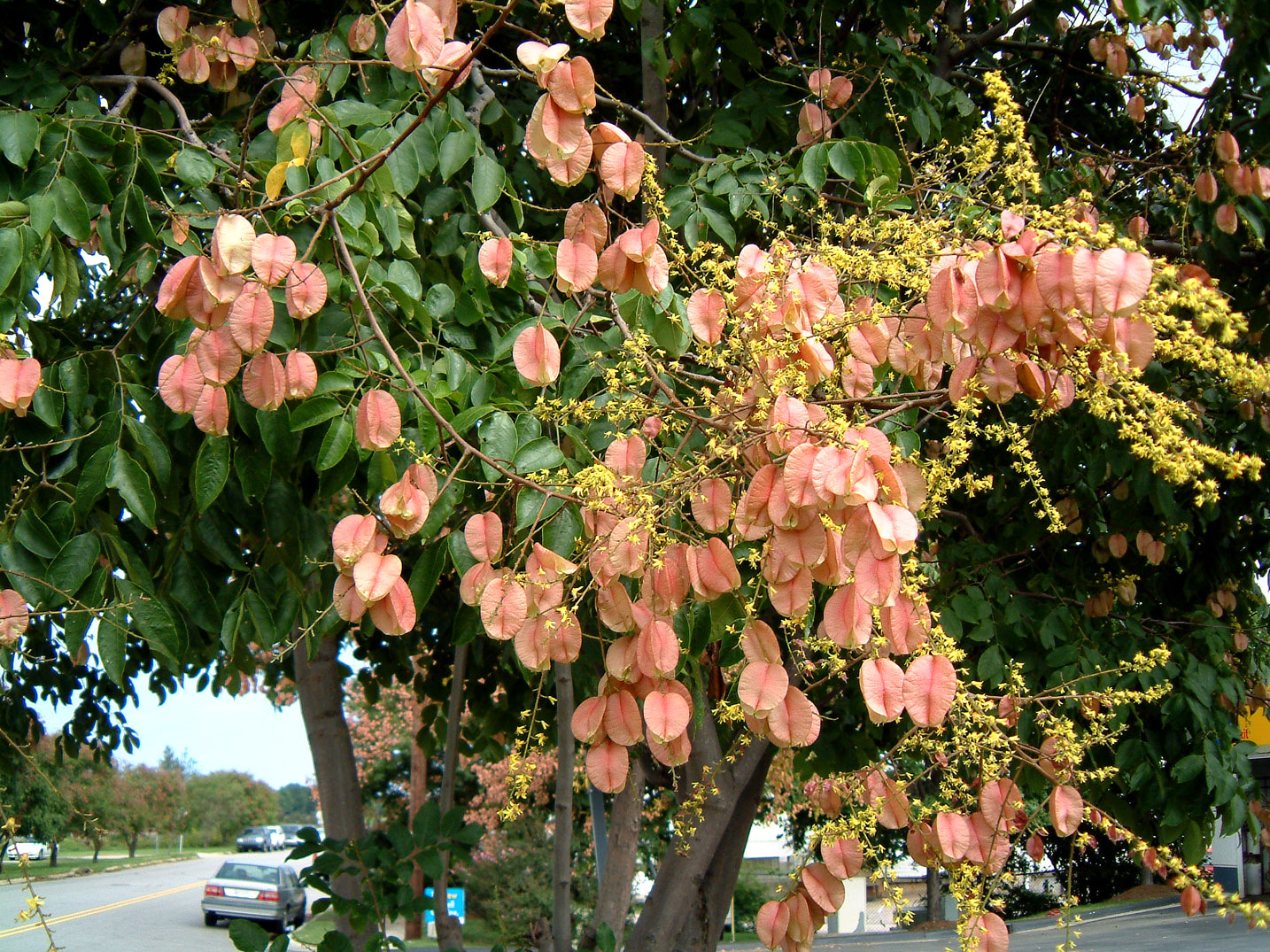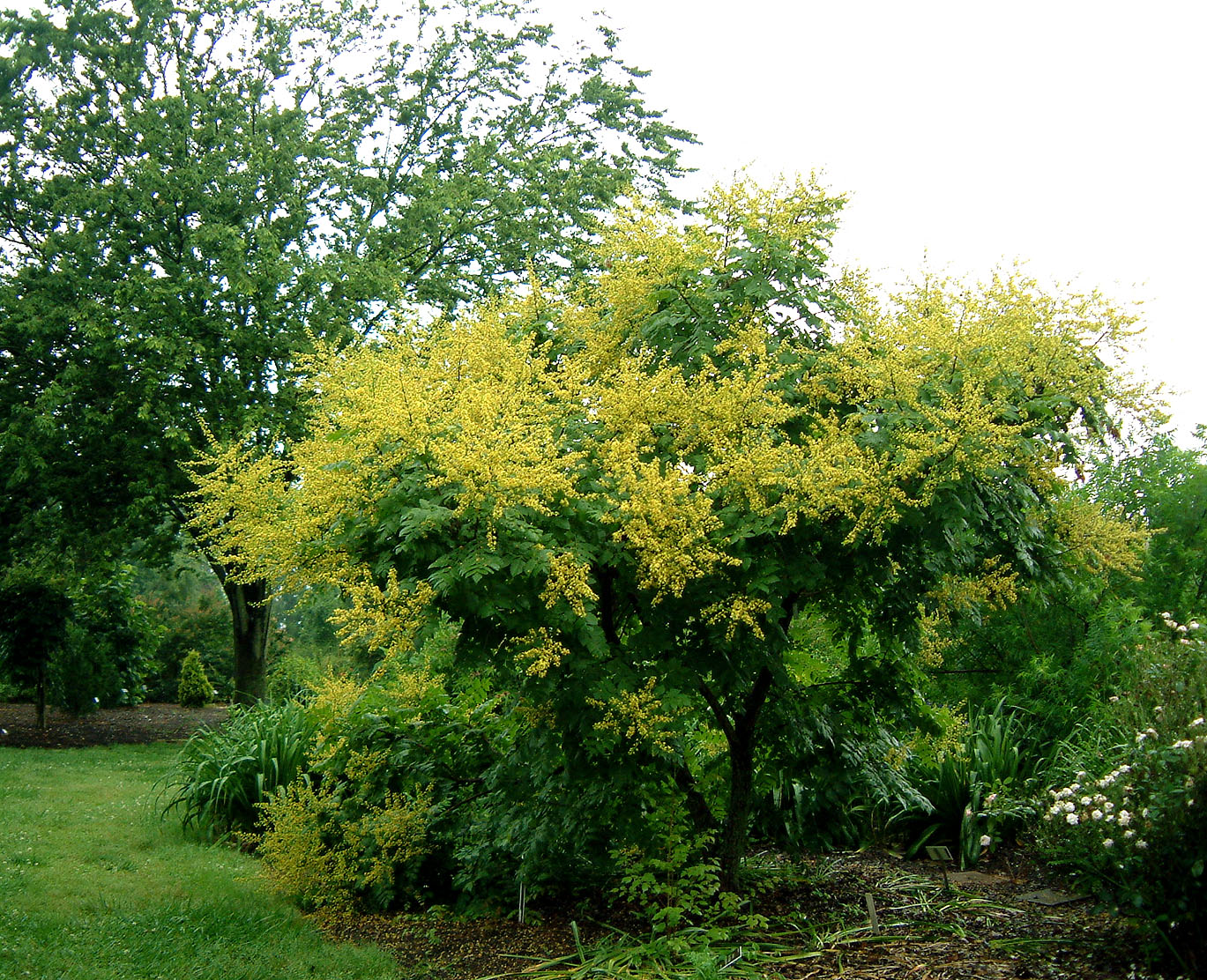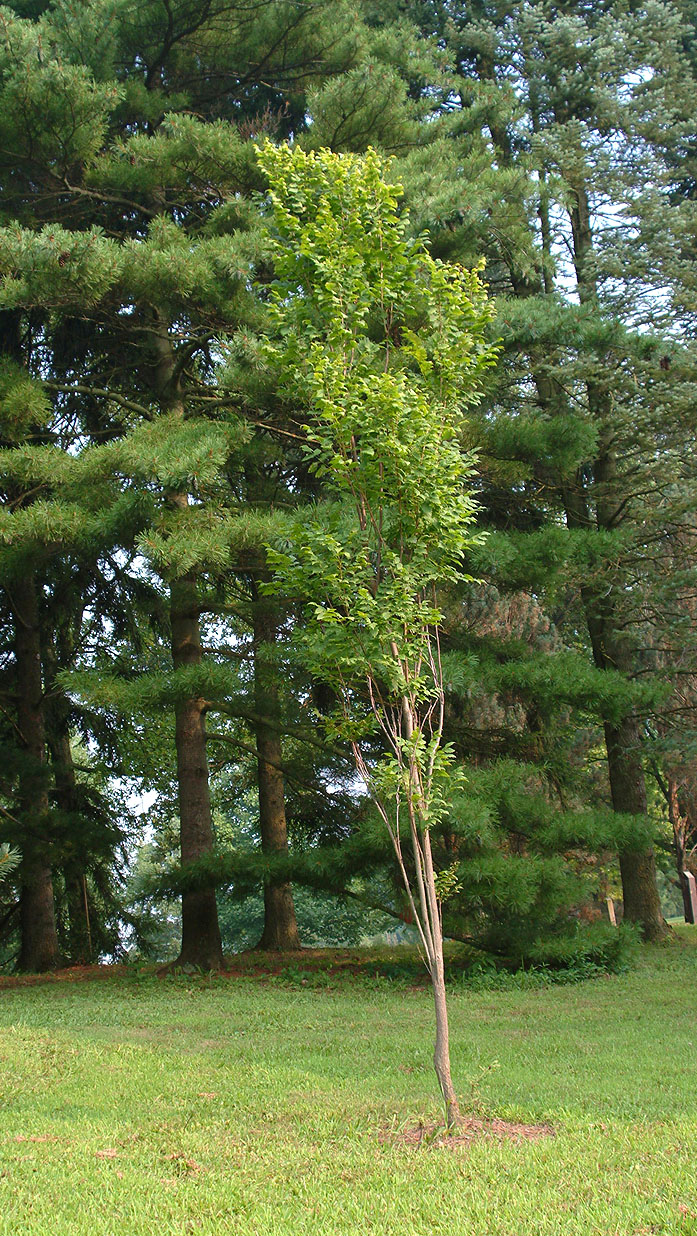NOS
KOELREUTERIA
PAGE |

|
Copyright
1988-2003. New Ornamentals Society. All Rights Reserved.
Lawful for online access only by current
society members.
All downloading, printing, saving to media, imaging,
screen capture, or offline use is prohibited.
Duplication by any means, method, or technology is
unlawful.
Do not link to this page. |
Koelreuteria
bipinnata showing its pretty salmon-rose lanterns
along with the last of the medium yellow, open panicled
flowers. If you look very close the row of K. paniculata
across this street have brown, dried fruit and have been
so for a full 6-8 weeks, some of them later than others.
This lovely species is not rare but it is uncommon among
the two species introduced from China. It will be new to
most designers and nurseryman and can be recommended as
one of the finest fall-blooming and fall-fruiting trees.
There are few more valuable yellow-flowering trees of any
chronology or size. The fruit can be collected in this
early pink stage, dried, and most of the pretty pigment
will persist. The species is quite durable in zones 6 and
warmer and I know that rules out some of your gardens and
clients. Plants tend to bloom fairly young, even in 5
gallon containers. The species is so fruitful,
seedling-scattering, and tough there is some concern it
could be a weed tree in the next generation. Our
experience shows that in your basic urban, commercial
setting there is no real problem. A country arboretum or
warm rural garden with adjacent woodlands might think
twice about this fertile beauty.
Click on
this image for larger version.
LCH
|
 'Beachmaster'
- click image to enlarge
'Beachmaster'
- click image to enlarge
Raulston Arboretum. June 2003. Blooming with the earliest of the species'
seedlings (some are a week or more later), this
half pint version of the wonderful species is more useful still. Name another
dwarf tree with gold flowers in summer that is
cold hardy in most states and countries?
Koelreuteria
paniculata 'Beachmaster'
ht: 8 ft. tall x 8-10 ft. wide (10 years)
ha: compact, semi-dwarf, half species height or less
fq: floriferous, as good as species typical
in: J.C. Raulston to US nursery trade 1990's.
Koelreuteria
paniculata CORAL SUN®
(5/3)
lc: pinkish-red new growth, very bright and showy, later yellowish-green with
red petioles
in, so: H Kolster (online catalog 2003)
 'Fastigiata'
- click image to enlarge
'Fastigiata'
- click image to enlarge
Dawes Arboretum. Summer 2003. It takes decades (if ever) for the cultivar to
become full and dense. The bases are often sparsely leaved.
Koelreuteria
paniculata 'Fastigiata'
ha: narrowly columnar
fq: unfortunately they're sparse and reside at the narrow top
where they are barely seen.
or: chance seedling at Kew Gardens UK in 1888. The seedstock was
from Shangai.
in: c. 1957 to US trade. lsp: original tree existed in 1973 at
Ruined Arch of Kew Gardens
li: Bean, W.J. 1929. Kew Bull. Misc. Inf. 4: 101. (as var.)"
li: Krussman, G. 1960. Hand. Laub. 43."
li: Meyer, F.G. 1976. A revision of the genus Koelreuteria. J.
Arnold
li: Arb. 57(2): 149.
Koelreuteria
paniculata 'Girard'
ft: sterile
bt: September - or much later. Since the species blooms in early June in warmer
climates, it is
bt: apt to be more towards August there.
rai: should be compared to 'September'
or: Girard Nurseries
Koelreuteria
paniculata 'Rose Lanterns'
frc: maturing fruit ('lanterns') bright pink and showy. Seedlings
of
frc: the species vary in shades of green, yellow, and pink with
this clone
frc: being one reliably towards the red-pigmented side of
spectrum.
bt: September (Arnold Arb.)
ns: reported confused with the original 'September'.
li: Santamour, F.S. and S.A. Spongberg. 1996. Koelreuteria
paniculata
li: 'Rose Lantern'. Arnoldia 56(2): 32-37.
Koelreuteria
paniculata 'Rosseels'
bt: blooms even on young plants
so: wholesale source (Firma C. Esveld)
Koelreuteria
paniculata 'September'
bt: app. 2 weeks later than typical (June-August) and often
September
bt: original tree was reported to start on August 25th in
Bloomington IL
it: inflor. larger and very densely branched.
so: Louisiana Nursery
or: Dr. J.C. McDaniel of Univ. of IL found on Bloomington campus
in 1958
or: or 1960
ns: late-blooming occurs in seedling populations so 'September'
and 'Girard'
ns: could easily be joined by other named variants.
prop: late-flowering according to McDaniel occurs in some
seedlings.
hp: considered as possibly cross to K. bipinnata
hsp: clonotype designed by Meyer as Meyer & Terrell 12459
(NA)
in: Scanlon Nur. of OH c. 1967
aw: Styler Award 1997 - Penn. Hort. Soc.
li: McDaniel, J.C. and March. 1967. Amer. Hort. Mag. 46(2):
95-96.
li: Wyman, D. 1967. More plant registrations. Arnoldia 27(8): 64.
li: Meyer, F.G. 1976. A revision of the genus Koelreuteria. J.
Arnold
li: Arb. 57(2): 149.
li: Dirr, M. 1991. Nursery Manager 7(9): 36
Koelreuteria
paniculata 'September Gold' = 'September'
tm: this name has been trademarked
ns: the name 'September' has been validly published and must be
retained.
li: Jacobson, A.L. 1996. North American landscape trees. Ten
Speed Press,
li: Berkeley, California. p. 76
Koelreuteria
paniculata 'Stadher's Hill'
frc: deep red - showy
or: Louisiana Nur.
li: Dirr, M. 1998. Man. Woody Land. Plts. Stipes Publishing.
Champaign, IL. p. 534.
DISCOVER THE BEST ENCYCLOPEDIA OF NEW
AND RARE PLANTS....
 click
logo for info
click
logo for info
Why is it better?
-
WEEKLY UPDATES from hundreds of
experts around the world. It never goes out of date. The NOD is a dynamic,
consistantly improved reference. This is what the internet is all about.
-
MORE CULTIVARS THAN MOST
REFERENCES. The NOD has the most cultivars for over 65 genera. As of March
2003 we had 84 Abutilon, 127 Achillea, 153 Agapanthus, 93
Aglaonema, 66 Ajuga, 256 Aster, 166 Astilbe, 125
Buddleia, 236 Campanula, 27 Campsis, 180 Canna, 70
Carex, 25 Clethra, 44 x Cupressocyparis, 75
Dieffenbachia, 42 Echinacea, 43 Erythronium, 95 Fagus,
16 Fothergilla, 64 Ginkgo, 73 Hamamelis, 23 Illicium,
90 Lantana, 57 Liquidambar, 63 Lobelia, 52 Mahonia,
70 Miscanthus, 93 Monarda, 47 Nandina, 102 Pieris,
23 Pennisetum, 98 Rosmarinus, 278 Salvia, 149 Sedum,
37 Sisyrinchium, 193 Thymus, 61 Tradescantia, 104
Veronica, and 53 Vinca cultivars.
Click here for more
cultivar counts.
-
Check your favorite
book - you'll probably find a half or fewer in each genus.
-
CURRENT, ACCURATE NOMENCLATURE
approved by horticultural taxonomists and explained in plain English.
-
FIRST CULTIVAR ANNOUNCEMENTS.
Many breeders and originators send their cultivar data to us first - weeks or
months before you see it in magazines or nursery catalogs.
-
LATEST LITERATURE from all over
the world. We spend hundreds of hours a year abstracting and distilling
articles on new and rare plants, their breeding, genetics, taxonomy, and
history. We also provide precise literature citations for use in your own
study and research. You'd have to spend over $10,000 a year to obtain all the
journals, books, checklists, CD-ROM, abstracts, newsletters, theses, and
dissertations that we examine and add every year.
-
CLICKABLE ONLINE SOURCES.
Knowing about new and rare plants is great. But we also help you find them for
your garden. The NOD has thousands of clickable links to online nurseries
offering a specific cultivar or rare species. And source links are added 52
weeks a year. And unlike most "plant finders" our links are TRULY
INTERNATIONAL - not just the usual American or British focus.
-
HIGH QUALITY DIGITAL PHOTOS. Our
large 3.4 to 6.0 megapixel digital images bring new and rare plants to life in
amazing detail, filling the screen. You find hundreds of fascinating photos on
all groups of plants - perennials, woodies, and tropical.
-
MORE DETAIL. We have cultivar
specific information, origins and history of cultivars, identification tips,
landscaping ideas, and trademark or patent data. You'll be amazed at how much
detail the other references leave out!
Find out how to order
today!



